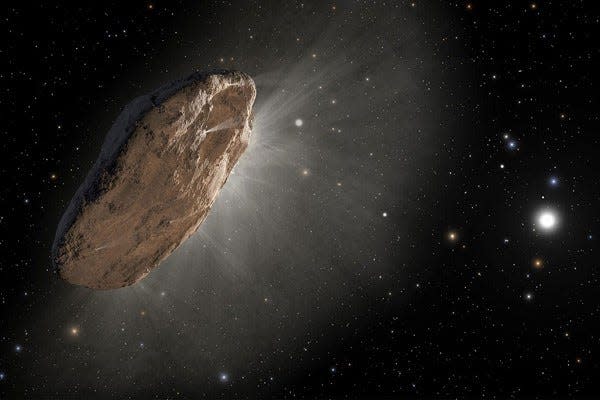This comet's weird orbit stumped astronomers for years. Now there's an answer for 'Oumuamua's strange path.
The strange outer-space object 'Oumuamua flew through our solar system in 2017 and captured our imaginations.
Meaning "scout" or "messenger" in Hawaiian, 'Oumuamua was the first known visitor from outside our solar system. It had no bright dust tail, like most comets, and had a peculiar shape – something between a cigar and a pancake.
But the object also had a weird orbit: It accelerated away from the sun in a way that astronomers could not explain, leading some to suggest it was an alien spaceship.
Now, in a study published Wednesday, the odd orbit of 'Oumuamua can be explained by a simple physical mechanism that's probably common among many icy comets: outgassing of hydrogen as the comet warmed in the sunlight.
THIS WEEK: Asteroid 300 feet wide to fly in between Earth and the moon

What is 'Oumuamua?
'Oumuamua was a comet traveling through interstellar space that was basically getting cooked by cosmic radiation, forming hydrogen as a result, said lead author Jennifer B. Bergner, an astrochemist at the University of California, Berkeley.
As it neared our sun, 'Oumuamua also warmed up and then released hydrogen, which slightly bent its path through our solar system.
The object was about a quarter-mile long, and astronomers first spotted it in October 2017 as it zipped through the inner solar system. Most comets are much bigger than 'Oumuamua.
"Because 'Oumuamua was so small, we think that it actually produced sufficient force to power this acceleration," Bergner said.
'Stupid, crazy ideas'
Astronomers say the comet may well have been wandering through our Milky Way galaxy, unattached to any star system, for hundreds of millions of years before its chance encounter with our solar system.
"What's beautiful about Jenny's idea is that it's exactly what should happen to interstellar comets," said study co-author Darryl Seligman of Cornell University. "We had all these stupid ideas, like hydrogen icebergs and other crazy things, and it's just the most generic explanation."
Interstellar comets actually pass through our solar system often
Scientists believe interstellar comets such as 'Oumuamua pass through our solar system about once a year, but they are faint and hard to spot.
The new study's findings support theories that ‘Oumuamua may have originated as an icy planetesimal – a small object formed during the early stages of planet formation – similar to other solar system comets.
The study was published in the peer-reviewed British journal Nature.
More on 'Oumuamua
From 2017: First asteroid from outside our solar system discovered
A year later: 'Oumuamua was a comet after all
Is it an alien? Here's what Harvard researchers say
This article originally appeared on USA TODAY: 'Oumuamua object's orbit explained: It was a comet, not a UFO